Exploring Unique Bathroom Vessel Sinks: A Guide
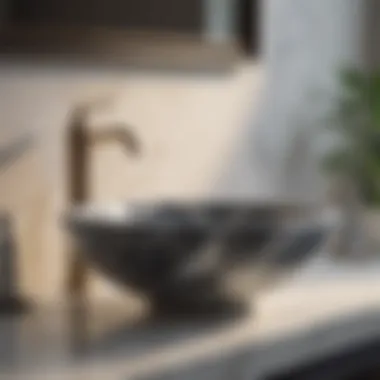
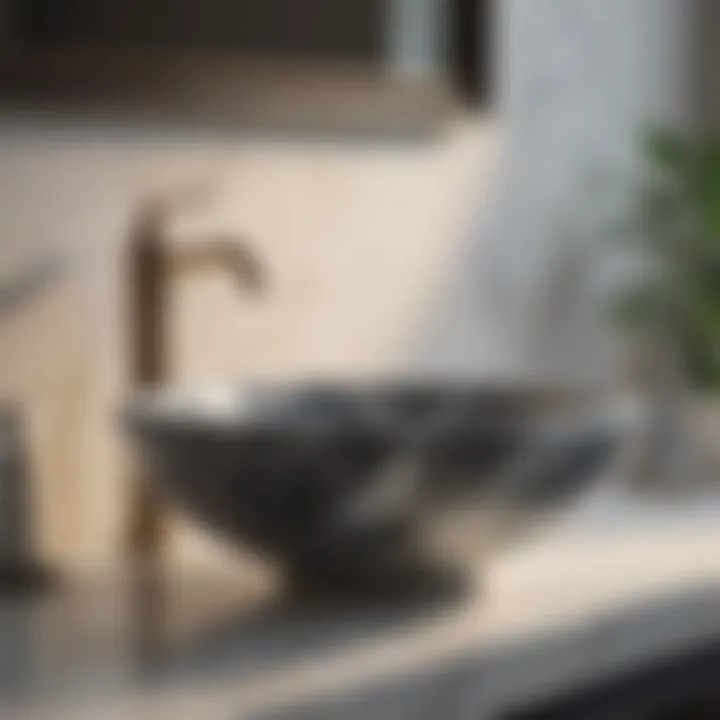
Intro
Vessel sinks have risen in popularity for their unique ability to blend functionality with visual interest. In the world of bathroom design, a vessel sink offers an excellent opportunity to add an original touch to your space. As emphasis on aesthetics increases in the realm of home improvement, understanding how to choose and install a bathroom vessel sink becomes crucial for homeowners and designers alike. This guide delves into the distinctive characteristics of these sinks, the advantages they provide, and the critical aspects you should consider when integrating them into your bathroom decor.
A diverse range of styles and materials exist, from glass and ceramic to stone and metal. Each of these materials brings different textures and color palettes, allowing for expansive design options to suit various tastes. Installation methods can vary as well, offering opportunities for creativity and innovation in design. As you embark on your journey to enhance the visual appeal of your bathroom, it is essential to comprehensively plan your project , understand the materials you need, and learn the best practices for installation.
By the end of this guide, you will be better equipped not only to choose the right vessel sink for your home but also to bring it to life in a manner that complements your overall design vision.
Materials:
Before starting any project, a clear list of raw materials is vital. Bathroom vessel sinks often require unique components based on your choice of design and installation method. Below is a detailed list of commonly needed materials along with suggested measurements:
- Vessel Sink: 18 to 24 inches in diameter.
- Sink Drain: Standard size of 1.5 inches, ensures compatibility with most plumbing fittings.
- Faucet: Optional for installation, often measuring between 8 to 10 inches in height.
- Sink Vanity Top (if needed): A good base support measuring at least 36 x 22 x 2 inches.
- Plumbing Kit: Includes piping, connectors, and fittings.
- Silicone Sealant: About 10 ounces, high-quality type recommended.
- Countertop Material: Granite, marble, or any preferred choice (consult based on specific height and width needed in area).
Suggested Tools:
- Phillips screwdriver
- Adjustable wrench
- Pliers
- Level
- Measuring tape
- Caulking gun
- Safety goggles
- Dust mask
Having all materials on hand as well as understanding the project scope helps reduce the potential for delays.
Once the materials are ready, we can move toward a detailed breakdown of installation steps.
Prelude to Bathroom Vessel Sinks
Bathroom vessel sinks offer a functional and stylish option for contemporary interior design. They provide an opportunity to enhance the aesthetic appeal of a bathroom, making it not only utilitarian but also a statement space. Understanding the elements of vessel sinks is important as homeowners look for unique ways to personalize their bathrooms.
Defining Vessel Sinks
Vessel sinks are characterized by their distinct installation style. Unlike traditional sinks, which sit below the counter or are built into the cabinetry, vessel sinks typically rest on top of the counter. This design showcases the sink itself, creating a focal point in the bathroom. The materials used in these sinks can vary widely, including ceramics, glass, stone, and metal. Each material presents different maintenance requirements and aesthetic qualities, appealing to various tastes and styles.
If you're considering integrating a vessel sink into your home, it's essential to examine the size and spacing around your sink. The right choice can greatly affect usability and overall comfort in the bathroom.
Historical Context
Historically, sink design has evolved through various cultural influences. The emergence of vessel sinks can be traced back to ancient civilizations, where practical needs met artistic expression. Environments in Asia and the Mediterranean have embraced using shapely basins to remind us of the beauty found in functionality.
Fast forward to modern times, vessel sinks surfaced as an innovative trend in the late 20th century, aligning with a broader move towards personalized decor. The introduction of diverse materials and designs allowed vessel sinks to cater to various preferences, further solidifying their place in contemporary bathroom design. Now, they are undeniably regarded as a versatile element of luxury and utility, adaptable to both minimalistic and opulent spaces.
Vessel sinks combine style and functionality, allowing every bathroom to achieve a personalized touch while maintaining practicality.
Types of Bathroom Vessel Sinks
The selection of a vessel sink goes beyond mere aesthetics. It plays a pivotal role in shaping the functionality and ambiance of a bathroom. Different types of vessel sinks come with various materials, styles, and considerations that cater to diverse design preferences and practical needs. By understanding each type, homeowners can choose the perfect vessel sink that marries form and function. This guide will delve into the four main types of vessel sinks: ceramic, glass, stone, and metal. Each type comes with unique qualities that can greatly influence the overall bathroom design.
Ceramic Vessel Sinks
Ceramic vessel sinks are one of the most popular choices in modern bathrooms. They are known for their versatility and durable surface. The key benefits of ceramic include:
- Wide Range of Designs: Ceramic sinks come in various shapes, colors, and finishes. This makes it easier to integrate them into different décor styles, from traditional to contemporary.
- Easy to Clean: The non-porous surface of ceramic ensures that stains and grime do not adhere, making maintenance straightforward.
- Affordability: They are often less expensive compared to other materials, offering good quality without breaking the bank.
However, while choosing ceramic, one must consider the weight and size. Heavier sinks may need additional support during installation. It’s also wise to avoid abrasive cleaners to protect the finish.
Glass Vessel Sinks
Glass vessel sinks offer a stunning visual appeal that easily catches the eye. They bring a level of elegance and uniqueness to a bathroom space. Consider these points:
- Aesthetic Flexibility: Glass can be clear, frosted, or colored, providing a multitude of visual choices. They fit well with modern and sleek bathroom designs.
- Transparency and Light: Glass sinks can create an illusion of space, often making smaller bathrooms feel larger due to their transparency.
- Temperature Sensitivity: It is essential to avoid extreme temperature changes. Sudden changes can cause the glass to crack.
The delicacy of glass also means that scratches and chips can happen. Hence, proper care must be followed to maintain its pristine condition.
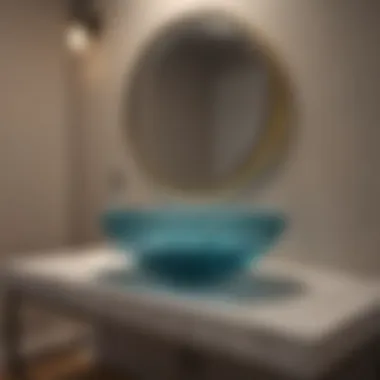
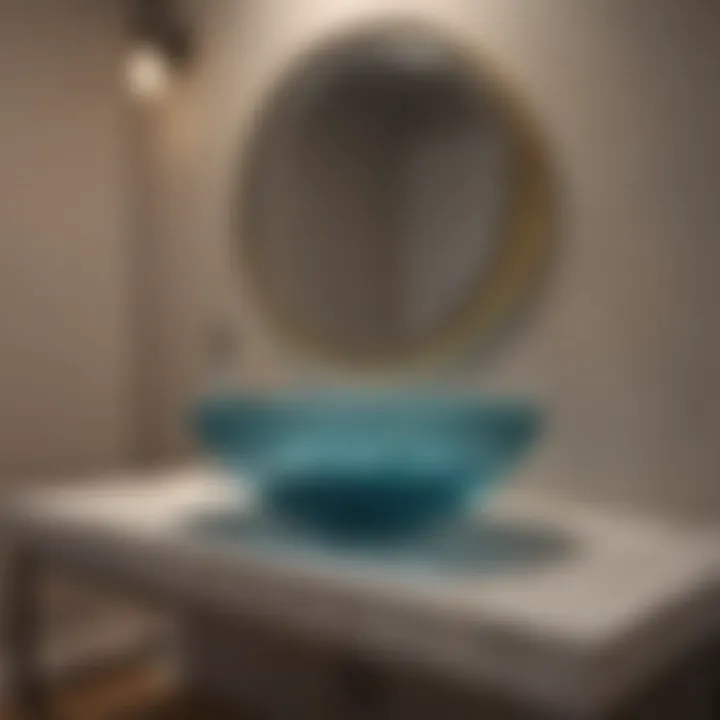
Stone Vessel Sinks
Stone vessel sinks introduce an organic touch to bathrooms by using natural materials such as granite, marble, or soapstone. Each stone sink is unique, highlighting advantages like:
- Timeless Beauty: The natural patterns and textures of stone can be breathtaking and set a luxurious tone in the bathroom.
- Durability: Stone is highly durable and can withstand hot and cold temperatures, making it an excellent option for a long-term investment.
- Heavy and Sturdy: The weight provides stability, but installation might require reinforced support.
Importantly, stone sinks generally require more care. They need sealing to prevent staining, especially with lighter hues.
Metal Vessel Sinks
Metal vessel sinks are a more contemporary choice that can add a modern yet rustic feel to bathroom designs. Common materials include stainless steel, copper, and bronze. Some significant aspects to look at are:
- Unique Aesthetics: The reflective surfaces of metal can create exciting contrasts within the bathroom decor. Copper and bronze offer a vintage look, while stainless steel caters to more industrial designs.
- Longevity: Metals can withstand corrosion when treated correctly and are comparatively easy to maintain.
- Careful Cleaning: Each metal has specific cleaning needs, and it's often important to avoid harsh cleaners to maintain the finish without scratching.
Design Considerations for Vessel Sinks
Designing a bathroom is a complex endeavor, requiring thought about numerous elements to achieve a harmonious balance. Among these elements, vessel sinks often act as both a focal point and a functional component. They add character while also serving the everyday needs of hygiene and convenience. Thus, it's important to carefully consider design aspects that will impact visual harmony and functionality in the space.
Aesthetic Appeal
The aesthetic appeal of vessel sinks cannot be overstated. A well-chosen vessel sink has the potential to elevate an ordinary bathroom into a visually pleasing oasis. These sinks come in a range of materials like ceramic, glass, marble, and metal.
A unique sink has capability to establish the overall design threshold of your washroom. Choosing a style that complements overall decoration is critical.
An artistic glass sink, for instance, can infuse a touch of elegance in a contemporary bathroom. On the other hand, rustic stone sinks are ideal for achieving a more traditional look. Given the diverse options available, homeowners should determine their desired ambiance before making a selection. The frequency of usage and the size of the area should also impact the chosen style.
Proportional Fit
Proportions matter greatly in design. An oversized vessel sink in a small bathroom can dominate the space and make it feel cramped. Conversely, a tiny sink in a large bathroom may appear lost and out of place. Therefore, ensuring a proportional fit is essential.
These considerations entail not just the dimensions of the vessel sink but also the surrounding elements, such as the countertop, fixtures, and overall space layout. An ideal approach would be to choose a sink that matches the size of the vanity or space to maintain balance. This careful planning assures that all components unite effortlessly to express the intended design vision.
Color and Finish Options
The color and finishes selected for vessel sinks can influence how they integrate into your design scheme. From sleek chrome to matte black or vibrant hues—finishes play a crucial role in unifying elements in this space. A glossy finish may exude a modern vibe, while a matte texture can provide a softer, more inviting atmosphere.
Consider these color and finish elements:
- Matching Existing Features: It is key to ensure that sinks coordinate with existing bathroom elements.
- Personal Style: Bold colors can help make statements, while neutral shades provide versatility.
- Maintenance Implications: Lighter colors may need more attention for cleanliness than dark shades, so practical aspects should not be overlooked.
Careful consideration of all these factors will create an overall design with function and visual appeal taking center stage in your bathroom aesthetics. Incorporating vessel sinks enrich the bathroom experience while maintaining balance within the space.
Installation of Vessel Sinks
The installation of vessel sinks is a crucial element in the transformation of bathroom spaces. These sinks not only elevate aesthetic appeal but also bring functionality to the forefront. Understanding key aspects of installation ensures that homeowners achieve a seamless integration of style and efficiency.
Preparation for Installation
Before starting the installation, thorough preparation is essential. Proper planning can significantly reduce complications later. Homeowners should measure the space where the sink will reside. Creating a clear layout helps avoid missteps during installation. Also, considering the weight of the sink material is critical; heavier materials like stone may require reinforced support. Check all tools and materials prior to beginning; this includes plumbing parts and a secure mounting method.
Plumbing Requirements
Another significant aspect is plumbing requirements. Correct plumbing connections are important for a functioning vessel sink setup. They guarantee appropriate drainage and prevent leaking. Typically, a pop-up drain assembly is necessary for vessel sinks. Also, ensure that existing plumbing aligns with the new sink. Adjustments to piping might be needed if the height or position of the sink changes. Therefore, examining existing plumbing lines is wise during installation preparation.
Mounting Options
Above-Counter Installation
Above-counter installation is a popular choice for many vessel sinks. This method allows the sink to sit on top of a counter, creating a striking visual element. One key characteristic of above-counter installations is their versatility. Homeowners can choose from a range of designs, making it easier to complement existing decor. The unique feature is the installation simplicity as it typically requires minimal modification to cabinetry. Though, caution is necessary; improper sealing can lead to water damage in the cabinetry over time.
Integrated Installation
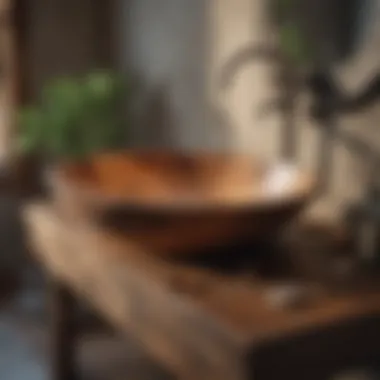
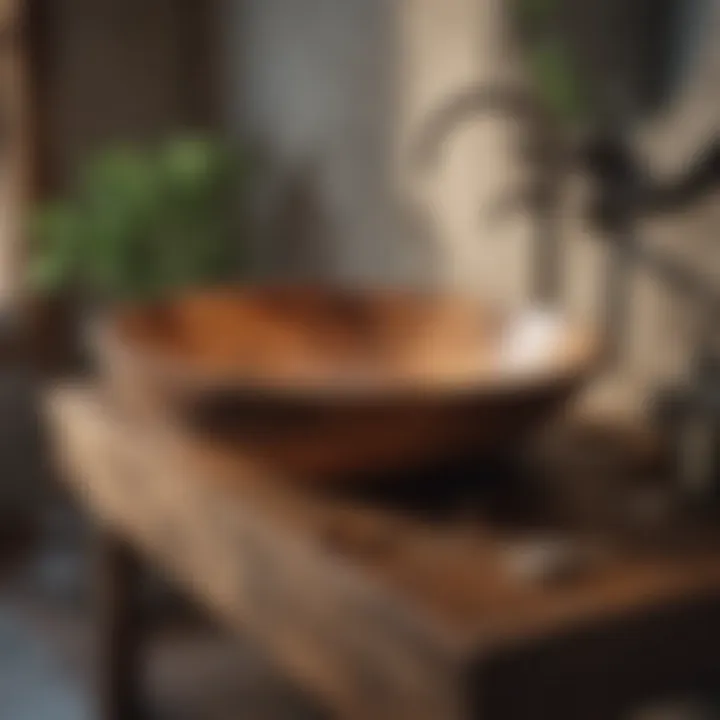
Integrated installation involves snugly installing vessel sinks within countertops. This choice provides a sleek appearance that appeals to modern aesthetics. A fundamental characteristic is the combination of sink and counter, allowing for easy cleaning due to fewer seams. Integrated installations often require precise measurements, which can complicate installation if not done correctly. However, this method may present limited style options comparing to above-counter designs. Homeowners appreciate the streamlined look, but should consider the extra effort project.
Proper installation of vessel sinks not only enhances their functionality but also elevates the bathroom experience overall. Investing time in planning and execution yields a durable and appealing result.
Maintenance of Vessel Sinks
Maintaining a vessel sink is crucial to preserving its beauty and functionality over time. Regular care and attention can enhance its durability and ensure it remains a focal point in your bathroom. Vessel sinks, typically mounted on top of the counter, require distinct cleaning regimens and preventative measures to avoid damage. This section discusses the cleaning techniques as well as strategies to avoid common wear and tear that might happen during everyday use.
Cleaning Techniques
The cleaning of vessel sinks should be approached with care to avoid damaging the surface. Depending on the material from which the sink is made, different cleaning methods apply.
- Ceramic and Porcelain Sinks: Use warm water mixed with mild dish soap. A soft cloth ensures the surface is cleaned without scratches. Avoid anything abrasive.
- Glass Sinks: For glass vessels, a solution of equal parts vinegar and water is effective. Spray it on, let it sit for a minute, and then wipe with a microfiber cloth. This helps avoid streaks.
- Stone Sinks: It is important to use a pH-balanced cleaner for granite and marble sinks. Stone is porous, so extra caution is needed during cleaning. Regular sealing may also be necessary to maintain integrity.
- Metal Sinks: Stainless steel or copper sinks can be cleaned with a gentle soap solution or non-abrasive cleaners specifically meant for metals. This ensures there are no scratches and helps prevent any oxidation for copper vessels.
Note: Over time, site-specific mineral deposits may form, especially in locations with hard water. Regularly inspecting and cleaning these deposits help maintain the sink's visual appeal and functionality.
Avoiding Common Damage
To prolong the lifespan of a vessel sink, there are several common damages to keep in check:
- Prevent Scratches: Whether the sink is made of glass or ceramic, avoid placing hard or abrasive items directly on the surface. Use trays or mats.
- Highlight Stains Before They Become Issues: Food, toothpaste, or soap residue should be wiped up promptly. Leaving them unattended might lead to stains and discoloration over time.
- Heat Sensitivity: Extreme heat can damage materials, particularly glass or certain coatings. Always use a mat or a trivet to protect the sink from hot items.
Key Point: Regular maintenance ensures beauty and performance. Infrequent care can lead to more substantial long-term issues, potentially requiring costly repairs or replacements.
- Check for Chipping: Ensure there are no chips or cracks in the sink, especially for stone models. Regular inspection will allow you to address issues sooner rather than later.
Consistent adherence to these cleaning and care strategies promotes longevity and performance of vessel sinks, thus preserving their elegant structure while preventing future inconveniences.
Vessel Sinks and Interior Design
Bathroom vessel sinks play a significant role in interior design. They are more than just functional items; they serve as bold design statements that can shape the look and feel of your bathroom. Understanding how vessel sinks integrate seamlessly with different design styles aids homeowners and designers in making structurally cohesive choices. Various characteristics and elements of vessel sinks influence the aesthetic and functional performance of the bathroom. This exploration delves into integrating vessel sinks into virtually any style of design, ensuring a full realization of design potential.
Integrating with Diverse Styles
Each design style brings distinct characteristics to the bathroom. Below are key styles to consider.
Modern Design
Modern design is renowned for its clean lines and minimalistic philosophy. A key characteristic is its emphasis on simplicity and functionality. The use of smooth surfaces and geometric shapes in vessel sinks contributes to an uncluttered atmosphere. This alignment with modern design values makes them a popular choice among homeowners who appreciate sophistication without excess.
A unique feature of modern vessel sinks is their variety of materials, often including ceramic and glass. These materials enhance durability and aesthetic value, adding to their appeal. However, the disadvantage lies in the potential lack of warmth, which might make a bathroom feel sterile if not balanced with appropriate accessories or colors.
Traditional Styles
Traditional designs evoke a sense of nostalgia and elegance. This style focuses on rich detailing and classic lines. A typical identifying feature is the generous use of decorative elements, including intricate cabinetry, vintage accessories, and ornate vessel sinks.
These sinks, crafted from materials like porcelain or hand-carved stone, exude luxury. They are appreciated for their ability to ground a space in history. However, integrating a traditional vessel sink can make the bathroom look busy if not harmonized with other design elements. Balance is essential to maintain a comfortable environment.
Eclectic Spaces
Eclectic design embraces an assortment of styles, materials, and vibrant colors. It is about combining items with unique characteristics into a cohesive look. The vessel sink in such spaces throws questionnaire about its purpose and statement. Versatile shapes and designs enrich this style, allowing for various creative expressions.
A distinct aspect of eclectic vessel sinks is their potential for customization. These sinks can be sourced from disparate cultures or styles, provide rich conversations pieces. Nonetheless, maintaining visual harmony amidst the varied pieces can present a challenge. Careful selection and placement contribute to creating a unified yet relaxed design.
Visual Impact on Space
The placement of vessel sinks can significantly affect a bathroom's visual impact. They often become the focal point, drawing the eye. Color and shape can help play up features already present in the space, enhancing overall aesthetic appeal. Homeowners tend to find that thoughtfully chosen vessel sinks bring balance and interest, enriching the bathroom experience as a whole.
Vessel sinks are structurally labor-unintensive yet dynamically versatile additions that thrive in creative design environments, paving the way toward unique and tailor-made spaces.
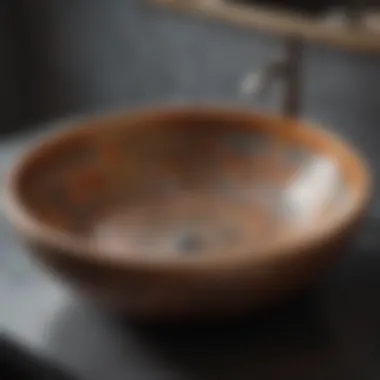
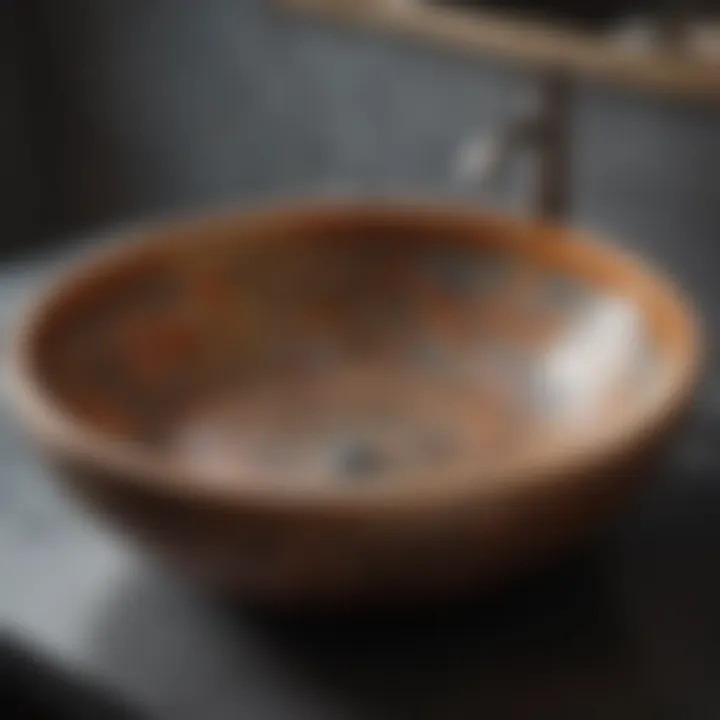
With the right considerations, swapping or installing a vessel sink may quickly elevate the space. The way a vessel sink enhances the balance, piques interest, and encourages functionality speaks volumes about design mutuality. Its importance lies not only in style but also in the curated flows of the entire environment.
Cost Considerations
Considering the cost implications of selecting bathroom vessel sinks is importnt for homeowners. Understanding the investment required in these unique sinks can affect not only the budget but also the long-term enjoyment of the bathroom. The price of a vessel sink can vary widely based on material, design, and brand, making it crucial to know what fits within your financial plan.
Pricing Range
The picing of bathroom vessel sinks ranges dramatically. You might find a simple ceramic sink for as little as fifty dollars, while a hand-blown glass or artisanal stone sink can reach prices in the thousands. It is essential to evaluate the overall budget, including additional costs for installation and accompdat equipment.
Factors affecting price include:
- Material: Ceramic is often more affordable, while exotic stone can demand higher costs.
- Design Complexity: Intricate designs and custom shapes typically increase the $cost$.
- Brand Reputation: Renowned brands may price their sinks higher than lesser-known names.
By understanding this range, homeowners can make informed decisions based on their kitchen renovation budge.
Long-term Value Assessment
The long-term value of a vessel sink transcends the initial cost. It involves considering durability, maintenance needs, and style longevity. High-quality vessel sinks can serve as both practical elements and statement pieces, impacting resale value.
When selecting a sink, consider:
- Durability of Material: Sinks made from natural stones like granite or quartz are often more long-lasting compared to cheaper options.
- Easy Maintenance: Some materials are easier to clean and maintain, reducing future costs.
- Timeless Design: A well-designed vessel sink can adapt to multiple styles, which can prevent future upgrades.
In many instances, investing a bit more upfront may save resourcess long-term. This resonant idea strengthens the bathroom's peeformance and enhances your quality of life by maintaining ideal conditions over time.
Premium vessel sinks may seem costly at first, but reevaluating them in terms of longevity, aesthetic appeal, and functional benefit can often render them invaluable assets in your home.
Trends in Vessel Sink Design
Trends in vessel sink design are noteworthy as they reflect evolving tastes and environmental considerations in home decor. With bathroom aesthetics playing a crucial role in fastidious interior planning, understanding recent trends can greatly benefit homeowners looking to enhance their spaces. This section will highlight two prominent trends that are gaining attention: sustainable materials and innovative shapes and forms.
Sustainable Materials
Sustainable materials in vessel sink design address growing concerns about environmental impact. Using resources that are renewable or recyclable not only minimizes waste but also appeals to consumers interested in eco-conscious choices. By exploring options such as bamboo, recycled glass, and reclaimed stone, homeowners can discover styles that marry aesthetics with ecological responsibility.
When choosing a sustainable material, consider the following benefits:
- Energy Efficiency: Many sustainable materials require less energy in their production.
- Longevity: High-quality, eco-friendly materials often stand the test of time, reducing the need for replacements.
- Unique Visuals: Sustainable inputs often result in distinctive appearances that can enhance personal style.
One example of a sustainable vessel sink is a bamboo sink. Prized for its fast renewal rate, it provides a unique texture that invites nature inside a home. Likewise, a sink made from recycled glass not only has a striking look, but its manufacturing process consumes less energy compared to conventional methods.
Recycling resources maintains their value and can give new life to the stream infused in your bathroom.
Innovative Shapes and Forms
The evolution of design extends into innovative shapes and forms for vessel sinks, breaking away from conventional square and round styles. Today’s landscape includes asymmetrical options, rectangular designs, and even organic, flowing shapes that draw inspiration from nature.
This trend allows homeowners to express individuality while optimizing space. Here are a few reasons to consider innovative shapes:
- Maximized Space Utilization: Unconventional forms can fit uniquely shaped countertops without sacrificing functionality.
- Focal Points: Beyond mere utility, unique designs become statement pieces or conversation starters, enriching the overall ambience.
- Functional Versatility: Many modern shapes enhance drainage and usability, proving form does not need to compromise function.
In adding a uniquely shaped vessel sink, one might opt for an ellipse to soften the hard lines of a bathroom, contributing to an elegant flow in decorative choices.
The examination of trends throughout vessel sink design not only showcases possibilities but highlights that hearth and home can reflect the contemporary values of sustainability and uniqueness. These trends represent more than style—they are insightful decisions defining bathroom spaces throughout contemporary settings.
Ending
In summarizing the exploration into vessel sinks, it is essential to recognize their relevance in modern bathrooms. Vessel sinks serve not just a practical function but also create significant aesthetic value. Each design choice contributes to the overall ambiance of the bathroom. Homeowners are seeking personalization in their living spaces. Thus, selecting the right vessel sink becomes a pivotal decision in bathroom decor.
Summary of Key Points
- Aesthetic and Functionality: Vessel sinks combine both style and usability, elevating the visual appeal of any bathroom while serving critical functions.
- Diverse Material Options: From ceramic to glass, the choice of materials affects not just looks but maintenance habits as well.
- Installation Considerations: Proper understanding on how to install vessel sinks ensures optimal usage and longevity. It shows the difference in installation methods.
- Current Trends: Awareness of modern design trends such as sustainable materials gives a broader perspective. It connects aesthetic inclination with responsibility.
- Cost Factors: Evaluating costs versus long-term value speaks directly to the return on investment. This assists homeowners in making informed financial choices.
Future Prospects
Looking ahead, the appeal for vessel sinks is likely to rise as design trends continue aligning with individual expressions of style. With ongoing innovation in materials and technology, we are bound to see exciting changes in shape and function. Furthermore, the focus on sustainability might grow. As manufacturers innovate with eco-friendly materials, the options for stylish designs of vessel sinks will become wider. It suggests a promising trajectory for the bathroom decor industry, intertwining style with responsible living. As consumers increasingly seek unique and personalized options in their home design, vessel sinks will likely play an integral role in enhancing distinctiveness while addressing practicality.







